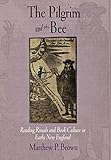The Pilgrim and the Bee : Reading Rituals and Book Culture in Early New England / Matthew P. Brown.
Material type: TextSeries: Material TextsPublisher: Philadelphia : University of Pennsylvania Press, [2015]Copyright date: ©2007Description: 1 online resource (288 p.) : 20 illusContent type:
TextSeries: Material TextsPublisher: Philadelphia : University of Pennsylvania Press, [2015]Copyright date: ©2007Description: 1 online resource (288 p.) : 20 illusContent type: - 9780812240153
- 9780812292053
- Books and reading -- New England -- History -- 17th century
- Books and reading -- New England -- History -- 18th century
- Literature and society -- New England -- History -- 17th century
- Literature and society -- New England -- History -- 18th century
- LANGUAGE ARTS & DISCIPLINES / Readers
- Cultural Studies
- Library Science and Publishing
- Literature
- 028/.9/097409034
- Z1003.3.N4 ǂb B76 2007eb
- online - DeGruyter
- Issued also in print.
| Item type | Current library | Call number | URL | Status | Notes | Barcode | |
|---|---|---|---|---|---|---|---|
 eBook
eBook
|
Biblioteca "Angelicum" Pont. Univ. S.Tommaso d'Aquino Nuvola online | online - DeGruyter (Browse shelf(Opens below)) | Online access | Not for loan (Accesso limitato) | Accesso per gli utenti autorizzati / Access for authorized users | (dgr)9780812292053 |
Frontmatter -- Contents -- Preface: A Phenomenology of the Book -- Introduction: Toward a Reader-Based Literary History -- 1. The Presence of the Text -- 2. Devotional Steady Sellers and the Conduct of Reading -- 3. Ritual Fasting -- 4. Ritual Mourning -- 5. Race, Literacy, and the Eliot Mission -- Notes -- Bibliography -- Index -- Acknowledgments
restricted access online access with authorization star
http://purl.org/coar/access_right/c_16ec
We conventionally understand the book as a vessel for words, a place where the reader goes to have a private experience with written language. But readers' relationships with books are much more complex. In The Pilgrim and the Bee, Matthew P. Brown examines book culture and the rituals of reading in early New England, ranging across almanacs, commonplace books, wonder tales, funeral elegies, sermon notes, conversion relations, and missionary tracts. What emerges is a new understanding of the book at once as a material good, existing within the economies of buying, selling, giving, and receiving; as an object of reverence and a medium for the performance of reading; and as an organizational system for word, sound, and image.The product of extensive archival research, The Pilgrim and the Bee brings together the disciplines of book studies and performance theory to reconsider the literary history of early America. Brown focuses on the reader's body, carefully studying reading practices during the first three generations of English settlement, with particular emphasis on the way such practices operated in the social rituals of the Massachusetts Bay Colony. Understanding Puritanism as a style of piety predicated on access to texts, he describes a canon of texts (devotional "steady sellers") that, with the Bible, served as conduct literature for pious readers. These devotional manuals were reprinted and read frequently and helped to shape the social identities of gender, race, class, faith, and age. To Brown, seventeenth-century devotional readers are both pilgrims, treating texts as continuous narratives of redemptive journeying, and bees, treating texts as flowers or hives, as spatial objects where information is extracted and deposited discontinuously.
Issued also in print.
Mode of access: Internet via World Wide Web.
In English.
Description based on online resource; title from PDF title page (publisher's Web site, viewed 24. Apr 2022)


